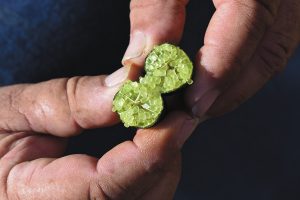Northern Valleys News first visited Marvick Native Farms in Red Gully in January 2016. A retirement project for Vickie Shina and Mark Andrew, their foray into the fledgling Australian Native Foods industry had turned into a flourishing enterprise.
Fast forward to 2020 and production of Marvick Native Farm’s star crop – the Marvick Desert Lime has tripled. Specially cultivated by Mark and Vickie, the fruit has an exceptionally palatable taste profile compared to other native lime varieties and is exported to Europe, used in gin distilleries and features in the kitchen of top restaurants nationally. Marvick Native Farms are also now an integral part of the emerging research into the benefits of bush foods for the pharmaceutical industry.
These medicinal qualities are what initially drew Vickie, a former nurse and medical sales representative, to growing the bush foods.
“With my medical background, I have a very keen interest in the properties of the Australian native plant varieties,” explains Vickie. “They are pure, untouched and have developed these amazing defence mechanisms over a very long period of time.”
These diverse plant defence mechanisms and how they can be harnessed to benefit humans are of particular interest to the both pharmaceutical and cosmetic industries.

Vickie explains, “These plants develop antimicrobial, antibacterial, antiviral defences to be able to survive. While the science is still unfolding, there are indications that, in particular, the sunrise limes contain a peptide with extreme antibodies that can help repair DNA and provide resistance to some diseases.
“It won’t give you the youth of life,” she laughs. “But it may strengthen your immune system.
“There is only one other fruit they have been able to extract this peptide from in the past, a Japanese mandarin heralded as a top medicinal fruit. The sunrise limes just knock the socks off of that.”
Thirty years ago, and ahead of his time, Mark had used native foods in his job as a chef in Victoria. A curious professional choice at a time when the sundried tomato was considered a gourmet accompaniment, now chefs all over — including from world-renowned Melbourne restaurant Attica — regularly feature native foods on their menus.
“I had cooked with rosella, lemon aspen, a lot of the tropical stuff, as well as paper bark and Warrigal greens, a native spinach,” explains Mark.
“It was certainly not popular! A lot of people were frightened to try it, and a lot of chefs didn’t know how to cook with it either. Now there are a lot more chefs around that understand the flavour profiles of the native foods and consumers have become more adventurous.”
Mark developed recipes for the gourmet bush food relishes, marmalades and infused olive oils (an award-winning collaboration with Catherine Lee at Regan’s Ridge Olive Oils) sold under the Marvick Native Farm label.
Desert limes are high in folate, calcium, lutein (great for eye health), vitamin E and have the highest known concentration of vitamin C of any citrus. The refreshing, lively and pleasantly sharp taste of desert limes means that it can be used in any context that a standard lime or other citrus would be used.
While Marvick Native Farms are in a year-round state of harvest across all their crops (along with the native limes they also grow bush tomatoes, hibiscus/rosella and quandongs,), the desert limes — which have the shortest flower to fruiting period of any citrus variety — must be harvested quickly and during the hottest part of the year. Fine tuning this system and getting help with labour have helped Mark and Vickie — who manage everything else on their 100-acre property themselves — to be able to keep up with commercial demand. Each tree of Marvick Desert Lime will produce between 50 to 80 kilograms of fruit and the crops are sold before they’ve even been picked!
“We have really improved our processing over the years – it was our biggest problem,” says Vickie.
“We have to pick 6 tonnes in 10 days so we get help in then,” explains Mark. “It’s off the tree, into the packing shed, bring the temperature down, into a freezer then Vickie takes them down to the city for snap freezing.”
Marvick Native Farms successfully obtained a Regional Economic Development Grant in February, which is being used to develop a grafting system for the Marvick Desert Lime variety. This will allow Mark and Vickie to bring contract growers and ramp up production of this nutritional powerhouse, the demand for which shows no signs of slowing.









